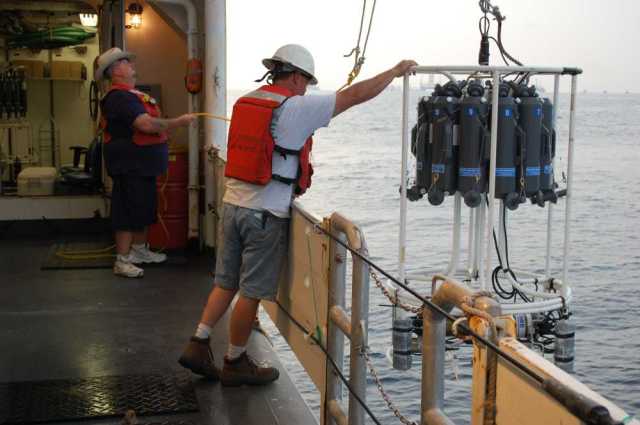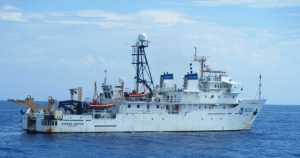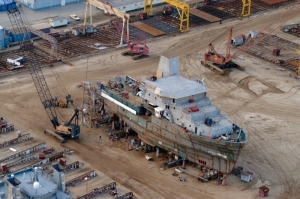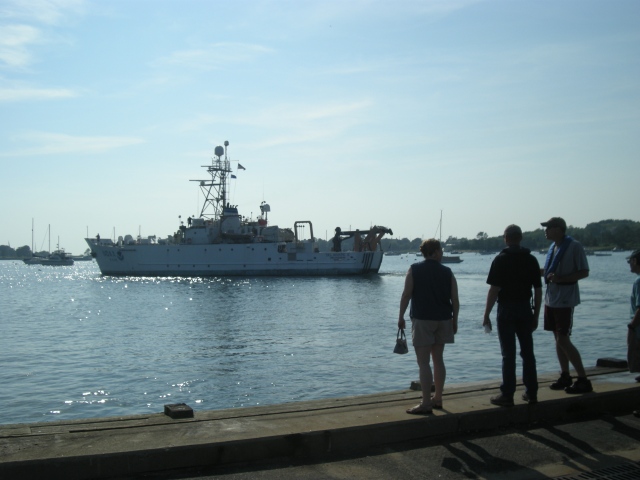Water sampling in deep water is a slow and tedious process. The conductivity-temperature-depth (CTD) instrument with water sampling carousel in a rosette pattern is lifted in the air by pulling up on the wire. A large metal frame, called an A-frame because it looks like the letter A, then swings out over the water and the instrument is lowered in. The following two to three hours are spent lowering the CTD at 50 meters (about 165 feet) a minute to near the bottom (~1500 meters, or roughly 5,000 feet deep) and then raising the CTD at 30 meters (about 100 feet) a minute back to the surface. The ascent is punctuated with stops to collect water samples, and turning the instrument off and then on adds a little extra time. Two to three hours of watching a computer screen for a scientist, and three hours of watching the winch controls for a crewman, is a typical CTD deployment.

General Vessel Assistant Carl Coonce and Skilled Fisherman Jon Jarrell deploy a CTD (conductivity, temperature, depth) rosette onboard the NOAA Ship Henry B. Bigelow. The Deepwater Horizon site is visible in the background. The CTD device detects how the conductivity and temperature of the water column changes relative to depth. Bottles mounted on the rosette are also used to collect water samples at different depths. Credit: NOAA.
The weather has been so calm that deployment and retrieval has been easy. The instrument comes aboard in reverse of how it went out. Once on board, various samples of water are taken from the bottles for analysis.
During the post-kill period when we were not permitted in the wellhead zone, we took on a gas chromatograph (GC), an instrument to separate and analyze chemical compounds in a sample, and a scientist from the NOAA Ship Gordon Gunter, which was returning to port after working on the Deepwater Horizon incident response. We also met the NOAA Ship Pisces and transferred our winch repairman to that ship, as the Pisces was having problems similar to those we had, and getting the repairman aboard the Pisces as soon as possible would them save a lot of time.
The onboard gas chromatograph (GC) analyses water samples for the volatile organic compounds that are found in oil. This near-real time capability allowed us to know what we were sampling, unlike the weeks to months it will take to get the results from the other samples we have collected that will be sent to a laboratory onshore. The results of the GC analyses were pretty clear: no volatile organics at depth.
At a few stations, however, we found toluene near the surface in low concentrations. Toluene is a colorless, flammable liquid obtained from petroleum or coal tar and used in fuels. The source of this contamination was unclear. If it was from oil, we would expect other volatile compounds to be present. We ran a number of control samples: rinse water only, dropping vials on the deck, holding water in bottles and then extracting. All of these controls contained no toluene, so at this point the source of trace amounts of toluene in surface samples remains unresolved.
The other water samples – the ones to be shipped off to a laboratory – will be analyzed for polyaromatic hydrocarbons (PAHs). These samples and their analyses will provide a much clearer picture of how much oil is left in the area around the wellhead. We were sampling within 10 kilometers or km (about six miles), and were part of a research fleet that had numerous ships sampling around the area of the well from 15 to 60 km (roughly 10 to 40 miles) distance.
As we neared the end of our cruise, we had made almost 30 CTD casts – or more than 60 hours of scientists and crew watching the computer screen and the winch controls.
Jon Hare
Chief scientist













